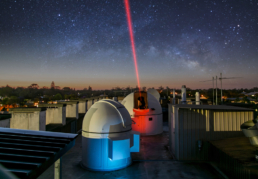
A UWA laser communications team has received a multi-million dollar grant from the Australian Space Agency to build a sovereign communications network that can send high-speed data to and from objects in space. WA’s Department of Jobs, Tourism, Science and Innovation supported the bid with $500,000, as did the University of Western Australia, making this a truly collaborative project between university, government and industry.
The $6.5 million project, which has just received a $4.4 million grant from the ASA as part of their support of NASA’s Moon to Mars initiative, will employ a new technology that uses super-fast lasers to talk to satellites and spacecraft at the International Centre for Radio Astronomy Research (ICRAR).
It’s called ‘free-space optical communications’, and is 1000 times faster than the radio communications currently used to communicate in space. The team form the Laser Communications and Timing Node of UWA’s International Space Centre.
Project leader Associate Professor Sascha Schediwy is a world expert in optical communications. He said the project—called TeraNet—will be one of the first commercial optical communications networks in Australia.
The network will be capable of providing day-to-day support to missions in space.
Schediwy says the network’s main commercial application will be transferring data to and from satellites orbiting the planet.
But the team also plans to develop capacity for high-speed communications to the lunar surface and beyond.
“It’s about supporting all these different customers and space missions in low Earth orbit,” Schediwy said.
“And then also being capable of advanced communications for things like NASA’s Artemis missions to the Moon.”
It means West Australian technology could transmit images from the first woman and first person of colour to land on the lunar surface.
The network will be made up of two fixed ground stations at UWA and Mingenew, and a third mobile station initially deployed at ESA’s New Norcia Deep Space Network.
Schediwy said NASA, ESA and other space agencies need communication stations worldwide to maintain continuous contact with missions as the Earth rotates.
“Western Australia’s geography and climate means it’s one of the best places in the world to host these ground stations,” he said. Western Australia is also positioned with a unique view of the sky inaccessible by our northern hemisphere neighbours.
Schediwy’s team will build the network with industry partners Goonhilly Australia and Thales Australia.
Goonhilly Earth Station chief executive Ian Jones said the company has collaborated with Schediwy and the UWA team for a few years to develop coherent optical ground-to-space communications.
“We are delighted to now see this move to the next exciting phase where we can assist in turning this into a technically mission-ready and commercially-operational service, especially for lunar communication,” he said.
“Goonhilly is the global pioneer in commercialising lunar communications and UWA is the world leader in this technology.
“This is precisely the reason we intend to grow our business in Western Australia and help to develop the lunar economy and the Australian space economy.”
“We have this leapfrog opportunity to get there first and develop this sovereign capability,” he said.
“And we can reap the benefits of having Australian industries and Australian researchers involved from day one.”
Australian Space Agency head Enrico Palermo agreed, and said the projects supported by the Agency show some of the many ways space technologies are improving how we live and work.
“By helping Australian organisations to develop their space heritage, they can break into new markets and supply chains and take their innovative Aussie technology to the world,” he said.
“That will help them to grow, keep their ideas in Australia and generate more employment opportunities here.”
The ASA’s Demonstrator Mission Grants support Australian businesses and researchers to develop space projects with a clear potential to support NASA’s inspirational endeavour to go forward to the Moon and then go on to Mars.
MORE INFORMATION
Leading the way in space research, capabilities and education at the University of Western Australia.
ICRAR
The International Centre for Radio Astronomy Research (ICRAR) is a joint venture between Curtin University and The University of Western Australia with support and funding from the State Government of Western Australia.
Department of Jobs, Tourism, Science and Innovation
JTSI are responsible for supporting the growth of the West Australian space sector to create jobs, diversify the economy, drive innovation and create a passion for STEM.

Goonhilly Earth Station has been the pioneering home of satellite communications since 1962. It continues to be recognised as a premier ground station of choice for the world’s major satellite operators, and has expanded its services to include lunar and deep space communications.
Thales Australia
Thales Australia is a trusted partner of the Australian Defence Force and is also present in commercial sectors ranging from air traffic management and ground transport systems to security systems and services. Thales Australia employs around 3,800 people directly and supports over 2,051 jobs along its Australian supply chain.
Thales Australia has a history of patient investment to build advanced in-country capability across manufacturing, critical systems and services. Close collaborative relationships with local customers, Australian SME suppliers and research institutions combined with technology transfer from our global business enables Thales to tailor high-quality solutions for Australian and export markets, generating revenue of $1.6 billion in exports over the past 10 years.
Geosience Australia
Geoscience Australia is the nation’s trusted source of information on Australia’s earth sciences.
We apply science and technology to describe and understand the Earth and we support evidence-based decisions by government, communities and industry through information, advice and services for a strong economy, resilient society and sustainable environment.
MULTIMEDIA
Video and images are available from Dropbox.
INTERVIEWS
Benjamin Dix-Matthews | benjamin.dix-matthews@uwa.edu.au | +61 402 499 263
MEDIA SUPPORT
Charlene D’Monte
ICRAR Media Contact | charlene.dmonte@icrar.org | +61 468 579 311| +61 8 6488 7758
Annelies Gartner
UWA University | annelies.gartner@uwa.edu.au| +61 8 6488 3229
Larissa Wiese
International Space Centre | riss.wiese@uwa.edu.au | +61 466 656 260
